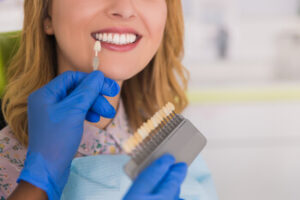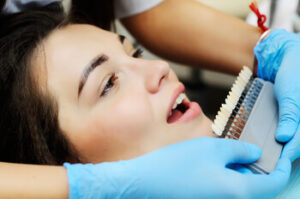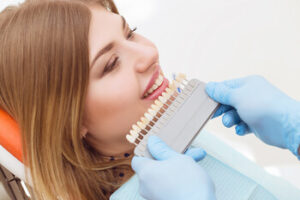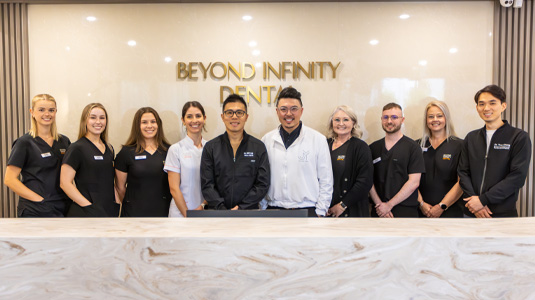Do you ever wonder if that Hollywood smile is more than just achievable for glamorous A-list stars? Whether you’ve been considering getting veneers or already know it’s in your near future, there are a few things to consider before taking the plunge. One of those considerations is whether or not to get shaved teeth prior to placing veneers.
In this blog post, we’ll discuss some core concepts related to teeth shaving and provide expert insights regarding its use during veneer placement. You can plan with confidence, knowing what’s involved so that when you do take the leap towards your gorgeous new smile, everything will go smoothly!
Overview On The Dental Veneers Procedure
Dental veneers can make all the difference when it comes to fixing your damaged, discoloured, chipped or crooked teeth. The process of placing a composite or porcelain veneer is a fairly straightforward one:
Impressions of natural teeth are taken, and then you’ll be fitted with temporary veneers until your permanent ones are created. After a few days, porcelain or composite veneers are bonded to the natural teeth, whichever suits the patient’s needs. Depending on the complexity of your specific situation, treatment usually requires two visits and can take anywhere from 2-3 weeks, with minimal upkeep afterwards.
Dental veneers can be an ideal solution if you’re looking to correct imperfections in natural teeth quickly and effectively.
How To Prepare Your Teeth For Veneer Installation
Suppose you consider veneers to improve your smile and enhance your natural beauty. In that case, you may be wondering about the best way for your tooth preparation before moving forward with the veneer procedure.
 Shaving the tooth surface is often necessary before installing a high-quality prosthesis like a dental veneer.
Shaving the tooth surface is often necessary before installing a high-quality prosthesis like a dental veneer.
Teeth shaving helps create space and allows the prosthetic to sit properly and naturally without affecting your bite or putting strain on other teeth in the mouth. A qualified dental professional should always do this preparation procedure with experience with veneer installation.
They will assess the level of enamel shaving needed for optimal prosthesis adherence and any further treatments, like whitening or surface treatments, that may be necessary before the process begins.
Don’t hesitate to ask questions during this consultation – it’s essential to understand exactly what procedures you’ll be undergoing before agreeing to any treatment plan.
Is It Painful To Get Teeth Shaved For Veneers?
Shaving a tooth before its veneer is applied may sound intimidating, but the procedure is typically not painful. Generally speaking, no anesthetic is required as you would get with a filling since no drilling or cutting of the tooth’s surface occurs.
Since only a thin layer of the enamel must be removed before applying the veneer, it’s normally not necessary to numb that area. Most people don’t feel much, if any, discomfort during the shaving process and many reports that the entire experience was pain-free.
So while it’s important to understand that getting teeth shaving for veneers does involve some alteration of your teeth, in most cases, you should expect little or no discomfort during or after the procedure.
The Benefits of Shaving Teeth for Veneers
Creating the perfect smile is within reach for anyone considering veneers, but the process can be intimidating for those unfamiliar. While shaving teeth down to accommodate this cosmetic dentistry procedure may seem a bit scary, several benefits make it worth your while.
 The main benefit of shaving teeth for veneers is this: because only a thin layer of tooth enamel needs to be removed, you can avoid any sort of pain or damage to surrounding nerves like what’s required when drilling in traditional dentistry.
The main benefit of shaving teeth for veneers is this: because only a thin layer of tooth enamel needs to be removed, you can avoid any sort of pain or damage to surrounding nerves like what’s required when drilling in traditional dentistry.
It also allows us to create perfectly smooth surfaces with which to adhere your new veneers and helps ensure they fit seamlessly on your teeth without sticking out or looking bulky.
With skilled professionals dealing with the technical details and experienced lab technicians creating custom-fitted restorations, you get both convenience and quality assurance when choosing a dental office for your veneer needs.
How Much Do They Shave Your Teeth?
The amount of tooth enamel removed during a veneer procedure varies from patient to patient. In some cases, only 0.3mm of the tooth needs to be shaved down, while in others, up to 1mm may need to be taken away before the veneer is placed.
Your dentist should be able to discuss the specifics of your case and advise you on whether teeth shaving for veneers is necessary in order to get the best results.
How Long Does Teeth Shaving Take?
The time frame for teeth shaving will depend on the extent of the procedure. Generally speaking, there’s no need to plan a full hour-long appointment when you come to get your teeth shaved. This is usually a very quick in-office procedure that should take at most 10-15 minutes.
Your dentist will be able to assess your veneer situation and provide you with the most accurate estimate of how long the procedure will take during your consultation.
Potential Risks Of Shaving Teeth for Veneers
Veneers can be an effective way to enhance the aesthetic appearance of your teeth and give you a beautiful white smile; however, there are potential risks to bear in mind before deciding on veneers.
Shaving off a portion of the teeth and bonding them with porcelain is necessary for successful veneer placement. This process can disrupt the enamel, weakening it and making it more susceptible to decay, staining, and chipping.
Additionally, veneers will not last forever, so periodically replacing them may be necessary in order to maintain optimal results.
To minimise these possible risks, visiting a qualified dentist specialising in veneer placement is important to ensure your procedure is done properly.
Different Types Of Veneers and Choosing The Right One for You
Veneers are popular and sophisticated dental treatments that can make a dramatic difference to the natural appearance of your teeth. If you are considering getting veneers, it pays to do your research and explore the different options available.
Porcelain veneers are known for their brilliant shine and longevity, while composite resin veneers have improved tremendously over time, providing an aesthetically pleasing finish with better value for money than porcelain.
Before deciding, discuss which material is best for you with your cosmetic dentist, as it depends on factors such as lifestyle habits and the natural condition of your teeth and gums. If cared for properly, either type of veneer can provide good results and significant improvements in the look of your smile.
The Disadvantages Of Veneers
When considering the disadvantages of veneers, a few common questions come to mind. For example, what is the cost factor? Secondly, are there painful dental procedures involved with getting them installed?
 Although veneers can provide significant benefits to someone who is seeking a quick and long-lasting aesthetic transformation, it is wise to consider all potential drawbacks before deciding.
Although veneers can provide significant benefits to someone who is seeking a quick and long-lasting aesthetic transformation, it is wise to consider all potential drawbacks before deciding.
From cost considerations to maintenance cycles to ensuring you get the highest quality products available, understanding all angles of veneers before investing in them can help you make an informed decision.
Ultimately, it is up to you to decide if you want to shave your teeth before getting veneers or not. You can weigh the pros and cons while considering the different types of veneers and the cost associated with them.
Tips on How to Maintain Your New Smile After Getting Veneers Installed
Once the veneers have been installed, taking care of your new smile is essential for its longevity. To maintain optimal results and protect your investment, there are a few simple tips you should keep in mind:
• Brush and floss regularly
Keeping up with good oral hygiene habits helps ensure that the veneers stay in their best condition.
• Avoid hard foods
Chewing on hard items like ice or candy can chip or crack the veneers, so always opt for the softer fare.
• Limit staining agents
Cigarettes, coffee and tea can stain your new smile easily, so avoid them as much as possible.
• Be gentle
Don’t use your teeth to open or hold things, as this can put too much strain on them.
 • Visit the dentist regularly
• Visit the dentist regularly
To ensure that your veneers are in perfect condition, a check-up with your dentist every 6 months for a routine cleaning and examination.
By following these tips, you can enjoy a gorgeous and healthy smile for years to come.
Conclusion
Shaving teeth prior to veneer placement is an important step in the process that should be noticed. By learning more about this procedure, you can decide whether it’s right for you and your goals.
When done correctly by a qualified dentist, tooth shaving for veneers can create a beautiful and natural-looking smile. You can enjoy your new smile for years to come with proper maintenance and care.
Restore Your Fabulous Smile
Choosing a dental clinic that has your best interest at heart is essential. Contact Beyond Infinity Dental today on (02) 8806 3799 to learn more about shaved teeth for veneers and what products and procedures will help you achieve your smile dreams!
Our professional and highly experienced team will be sure to provide excellent advice while walking you through each step of the way with care and expertise. We look forward to hearing your story and helping you on your journey towards a beautiful smile perfect for any occasion!
Sources
Clip-In Veneers UK: The Dangers of Buying Snap-On, Temporary Teeth Online
https://www.dentaly.org/en/complete-guide-to-veneers/clip-in-veneers/
Veneers
https://my.clevelandclinic.org/health/treatments/23522-dental-veneers
The Success of Dental Veneers According To Preparation Design and Material Type
https://www.ncbi.nlm.nih.gov/pmc/articles/PMC6311473/










